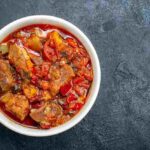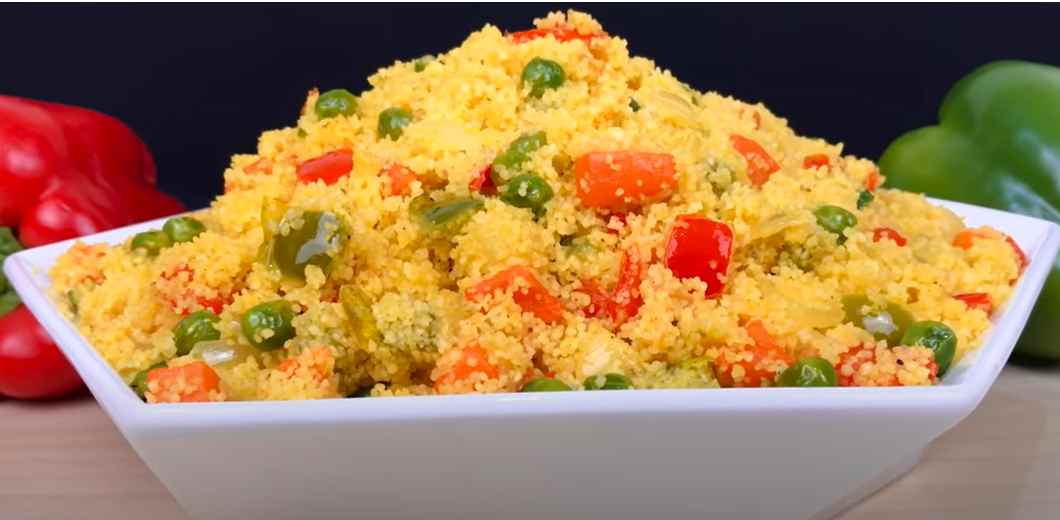Couscous de Timbuktu is a versatile and beloved North African dish people around the world enjoy. Its origins can be traced back centuries to North Africa.
The pasta is a product of rolled, moistened semolina from wheat. The granules are then steamed until they are light, fluffy, and tender. The result is a delightful texture that easily absorbs the flavors of the ingredients you cook it with.
Become an insider. Subscribe to our newsletter for more top trending stories like this!
What is Couscous de Timbuktu?
Couscous is a North African pasta with tiny grains made from semolina flour. Its texture looks like grains of rice or quinoa, but it’s actually pasta! A traditional food of the Maghreb region of Algeria, Tunisia, Mauritania, Morocco, and Libya, the Berbers developed it between the 11th and 13th centuries.
It contains gluten because it’s made from wheat. So, if you are following a gluten-free diet, stay away from it or look for gluten-free couscous.
One aspect of this dish’s appeal globally is its remarkable adaptability. This allows for a wide range of recipe variations using additional ingredients. It’s a fantastic main or side dish that pleases almost any palate because you can add fruits, vegetables, and meats.
People Also Read: Recipe: Delicious Binyebwa | Ugandan Groundnut Sauce Recipe
Types of Couscous
There are two major types:
Traditional Couscous
This type has tiny, irregular grains, and it cooks fast. It’s the standard variety and is labeled “couscous” at the grocery store. It’s often called Moroccan couscous.
Israeli couscous
The pearl shape gives it a nickname, pearl couscous, and it’s large and shaped like balls. Due to its large and similar-shaped grains, it should be considered pasta rather than couscous.
Unlike the traditional type, Israeli couscous is always machine-made. A government-sponsored initiative to feed immigrants in the 1950s led Israel to develop Israeli it.
Become an insider. Subscribe to our newsletter for more top trending stories like this!
How to Cook Couscous de Timbuktu
Ingredients
- 1 cup couscous
- 1 cup broth or water
- 2 tablespoons pine nuts
- 1 tablespoon fresh lemon juice
- 2 tablespoons chopped parsley
- ¾ teaspoon sea salt, more to taste
- 1 tablespoon plus 1 teaspoon extra-virgin olive oil
Instructions
Always use a 1:1 ratio of couscous to water or broth.
- For one cup of couscous, boil 1 cup of broth or water in a saucepan. Add a small drizzle of extra virgin olive oil and a pinch of salt. Bring water to a boil.
- Pour 2 teaspoons of olive oil into a skillet. This is an optional step but can make a difference in imparting flavor. Add the uncooked couscous and toss around constantly, using a wooden spoon. You’re looking for it to gain a beautiful golden brown color.
- Add the golden hue pasta to the boiling water.
Stir the toasted couscous into the boiling water. Cover the saucepan and remove from heat or turn the heat off immediately. - Allow the couscous to sit undisturbed for about 10 minutes until it has absorbed all the water. Uncover and fluff with a fork. Taste and adjust the salt to your liking.
- Optionally, you can add some spices and herbs for flavor.
You can serve your couscous plain at this point. Or, feel free to add a little seasoning of your choice and some fresh herbs like ground cumin, chopped parsley, dill, and green onions. You can add some vegetables like carrots, onions, sweet corn, and green peas. - Once you add the flavorings of your choice, give the pasta another toss to combine, and transfer to a serving platter. Enjoy!
Couscous Serving Ideas
Once you’ve cooked your couscous, you have all sorts of options. Here are a few ideas
- Add Mali’s couscous to a salad by mixing it with vegetables and dressing. You can also use it instead of quinoa, bulgur, or millet in a grain salad.
- You can top the couscous with stew. Traditional couscous is often served with stewed seasonal vegetables.
- Make it a complete meal. To make a quick meal, top Couscous de Timbuktu with roasted vegetables like cauliflower, Brussels sprouts, butternut squash, tahini sauce, and your preferred protein.
- Serve under seafood like shrimp, salmon, salmon cakes, or scallops
People Also Read: Recipe: The Fluffy Algerian Baghrir Pancake Delight
Tips for Perfectly Cooked Couscous
- Follow the 1:1 liquid-to-couscous ratio. If you plan to cook 1 cup of couscous, you’ll need 1 cup of boiling broth or water. To be sure, read the couscous package, as some may require a different ratio. However, using less liquid may be ideal for mixing it with a salad.
- Use broth as the liquid for your cooking. You can use either water or broth, but broth will flavor your couscous more quickly.
- Before cooking the couscous, toast it a little bit. There’s no need to do this step, but it adds a lot of depth of flavor and subtle nuttiness to the dish. Toast it in extra virgin olive oil before adding it to the boiling liquid. The couscous should turn golden brown after a few minutes. Make sure it doesn’t overbrown.
- Do not disturb the couscous when pouring the hot broth. Stir, remove it from the heat and allow the hot liquid to absorb it fully.
- Another serving idea is to fluff the couscous with a clean fork and jazz it up with flavor. Add a little spice or fresh herbs to infuse more flavor if you like.
Video Credit: Cooking Basket
Cooking Basket is a cooking YouTube channel where you’ll find delicious dessert recipes in easy ways.

Mali’s Couscous de Timbuktu
Equipment
Ingredients
- 1 cup couscous
- 1 cup broth or water
- 2 tablespoons pine nuts
- 1 tablespoon fresh lemon juice
- 2 tablespoons chopped parsley
- ¾ teaspoon sea salt more to taste
- 1 tablespoon plus 1 teaspoon extra-virgin olive oil
Instructions
- For one cup of couscous, boil 1 cup of broth or water in a saucepan. Add a small drizzle of extra virgin olive oil and a pinch of salt. Bring water to a boil.
- Pour 2 teaspoons of olive oil into a skillet. This is an optional step but can make a difference in imparting flavor. Add the uncooked couscous and toss around constantly, using a wooden spoon. You’re looking for couscous to gain a beautiful golden brown color.
- Add the golden hue couscous to the boiling water.
- Stir the toasted couscous into the boiling water. Cover the saucepan and remove from heat or turn the heat off immediately.
- Allow the couscous to sit undisturbed for about 10 minutes until it has absorbed all the water. Uncover and fluff with a fork. Taste and adjust the salt to your liking.
- Optionally, you can add some spices and herbs for flavor.
- You can serve your couscous plain at this point. Or, feel free to add a little seasoning of your choice and some fresh herbs like ground cumin, chopped parsley, dill, and green onions. You can also add some vegetables like carrots, onions, sweet corn, and green peas.
- Once you add the flavorings of your choice, give the couscous another toss to combine, and transfer to a serving platter. Enjoy!
Video
Nutrition

Interested in watching the full article video? See below. Subscribe to our YouTube channel for more original, inspiring videos on the black experiences.
Nearly 80% of consumers visit directories with reviews to find a local business. List your business for free in our exclusive Spotcovery Black-Owned Business Directory.
Spotcovery offers unique and fresh daily content on Black culture, lifestyle, and experiences. We talk about everything black, black people, black-owned and black-owned businesses. We also deliver authentic and relevant content that will inform, inspire and empower you! The future of black media is a critical piece of the black experience of today! Our primary audience includes African American, African, Afro-Caribbean and people of African heritage. Black culture is for the culture!
Become an insider. Subscribe to our newsletter for more top trending stories like this!





